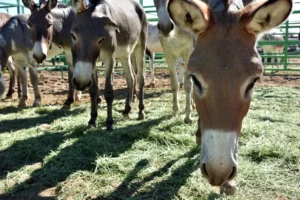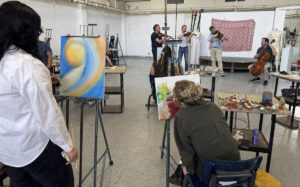The Struggle of Fremont Cottonwoods Amidst Rising Heat and Drought in Arizona
Amidst the sweltering heat and unrelenting droughts in Arizona and the broader Southwest, a vital component of the desert ecosystem is facing significant challenges. Recent research highlights how these extreme conditions are impacting the ability of trees to maintain their temperature, posing a threat to their survival.
Published in October in the Proceedings of the National Academy of Sciences, the study focuses on the iconic Fremont cottonwood. This tree is not only crucial for supporting various other species but is also known for its resilience in varying climates, from Phoenix’s scorching summers to Flagstaff’s chilly winters.
However, as heat waves intensify, the tree’s ability to self-cool through its leaves is increasingly jeopardized, explained co-author Alexandra Schuessler, a lab manager at the Desert Botanical Garden in Phoenix. The dual stresses of heat and insufficient water resources, exacerbated by climate change and altered watersheds due to dams, are proving detrimental to these trees.
“Human-caused water limitation coupled with the increase in heat and drought throughout the Southwest is going to be very hard on these trees, which will in turn create habitat loss and stress on other species that depend on cottonwoods for shade; food, such as beavers; and nesting sites,” Schuessler stated. “This paper and others like it continue to build a case that climate impacts and water resource management are going to drastically change our world unless we make some major changes.”
Discoveries from the Study
The research team conducted experiments using potted Fremont cottonwoods at the Desert Botanical Garden, allowing them to manipulate environmental conditions. They examined four different populations of these trees during July 2023, the hottest month recorded globally at that time, affixing sensors to the leaves to gauge temperature changes.
Despite extreme temperatures, the cottonwoods could still cool their leaves below lethal levels through evaporative cooling, akin to human sweating. Although the trees survived the heat waves, their survival hinged on adequate water availability—a resource becoming scarcer as the region grows hotter and drier.
“Even when temperatures reached 118 degrees Fahrenheit, which stressed both the trees and the research team, the trees were able to prevent overheating, especially the trees from the hottest locations from the lower Colorado River,” Schuessler noted. “However, experimentally limiting water leveled the playing field, and trees from all four populations suffered from a combination of heat stress and drought.”
Implications of the Findings
For the water-dependent Fremont cottonwood, these findings are alarming. These trees prosper when their roots access water, but their survival is threatened as streams dry up. Schuessler highlighted Lake Havasu, where a once-thriving cottonwood population has perished due to limited water and extreme heat, eliminating crucial habitats for various animals. Even if water levels rebound, the return of these trees is uncertain, hinting at a potential contraction of their range in the future.
The loss of these desert forests could have repercussions for human populations in the Southwest, Schuessler warned. Trees aid in cooling streams, boosting oxygen levels, providing shade for outdoor activities, controlling erosion, and enhancing biodiversity.
“The average person, especially the average person in the desert, is often drawn to water and to sit beneath the shade of a tree watching the water flow,” she said. “Cottonwoods are an important part of the so-called ‘ribbon of green’ along our desert rivers that provide us with that shade.”
Future Directions
The research team plans to reintroduce trees from warmer areas into degraded zones to restore these ecosystems. This study sets the stage for future restoration and conservation efforts, according to Schuessler.
The project involves collaborations between Desert Botanical Garden, Northern Arizona University (NAU), UC Berkeley, and UC Santa Barbara, with contributions from NAU researchers Hillary Cooper, Chris Doughty, Catherine Gehring, Thomas Whitham, and Gerard Allan.
Read More Here










